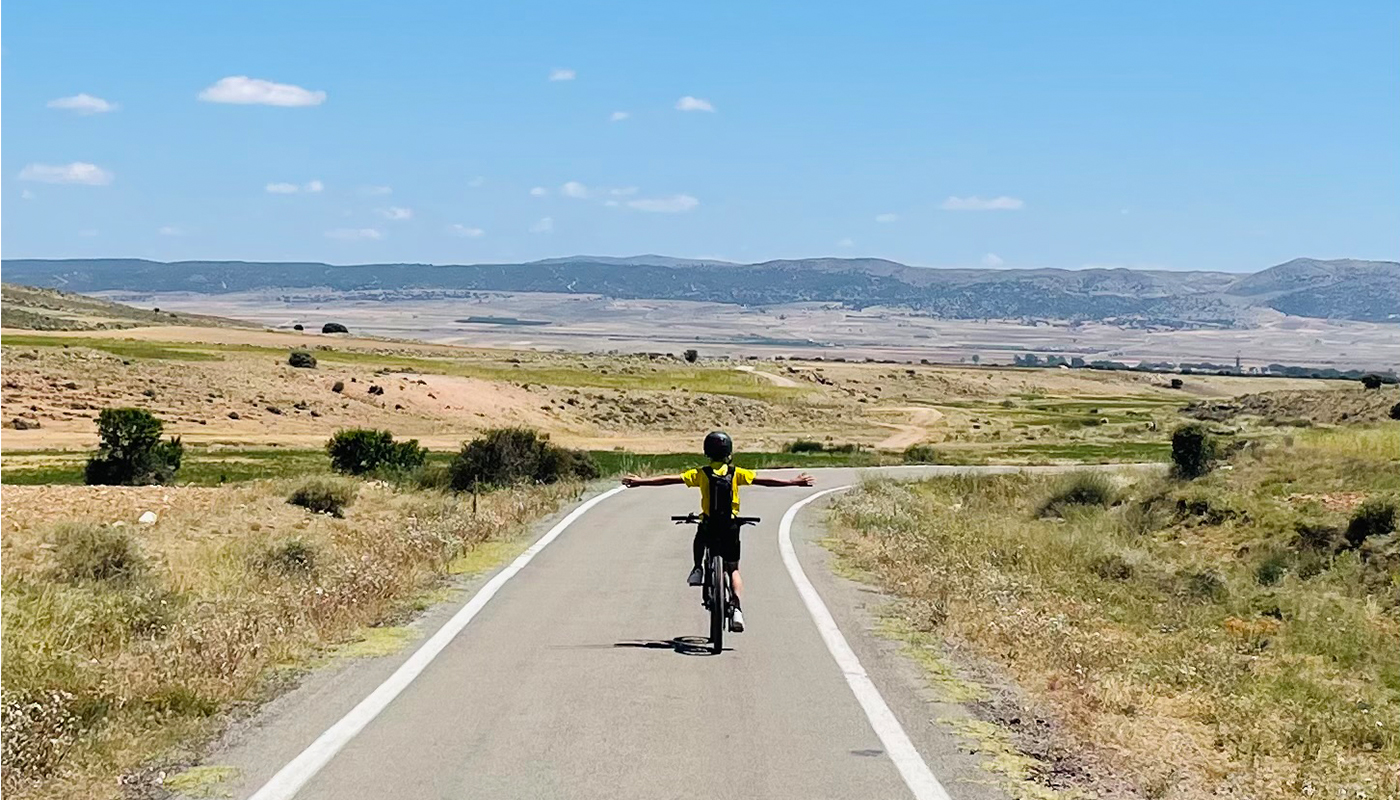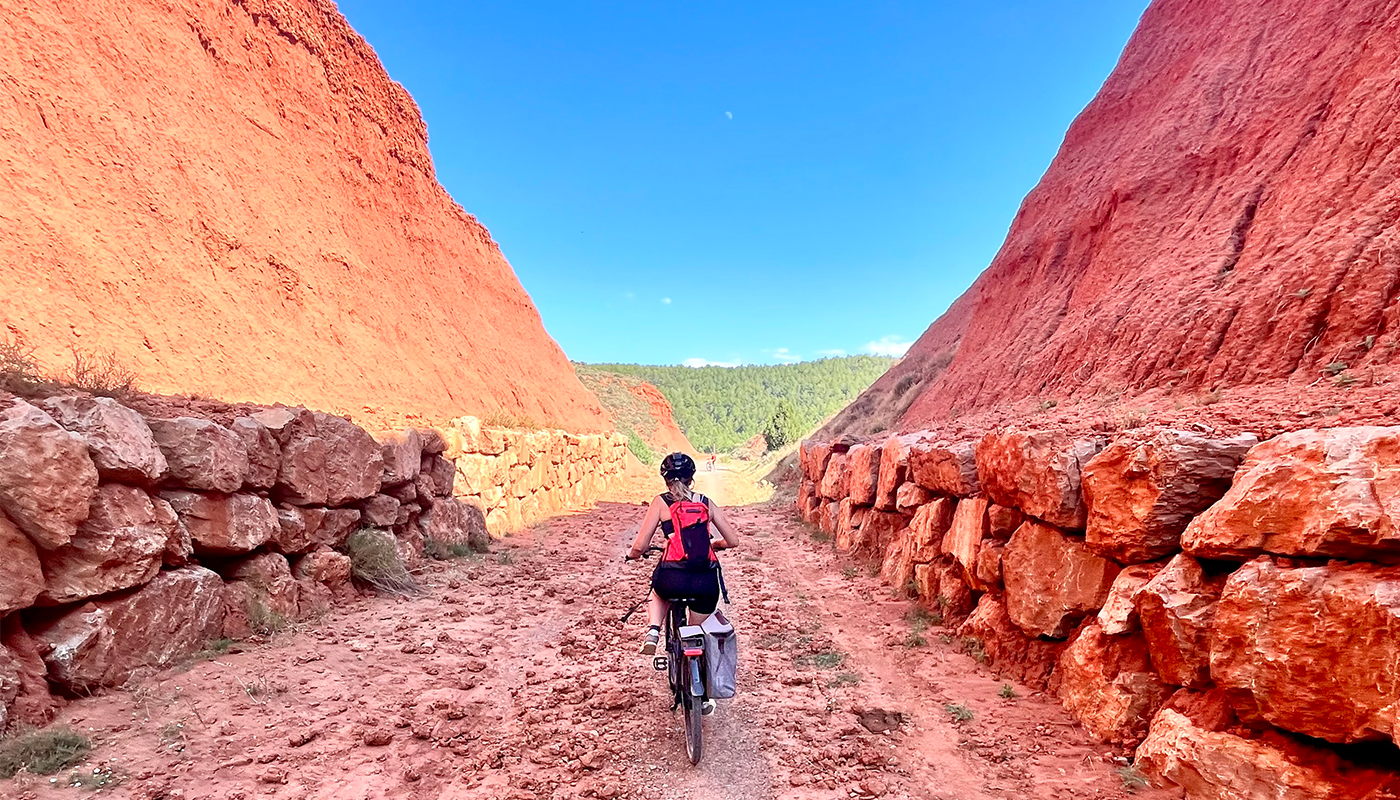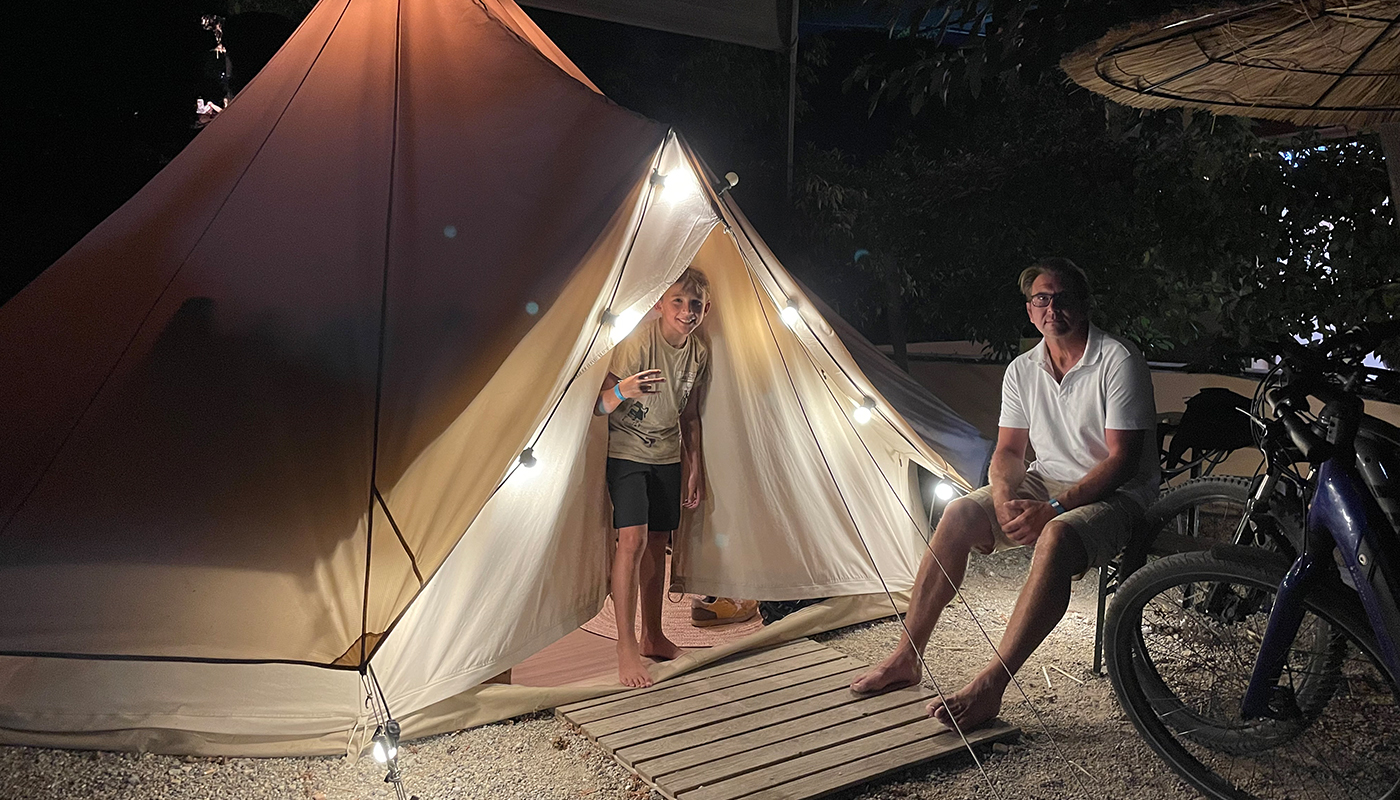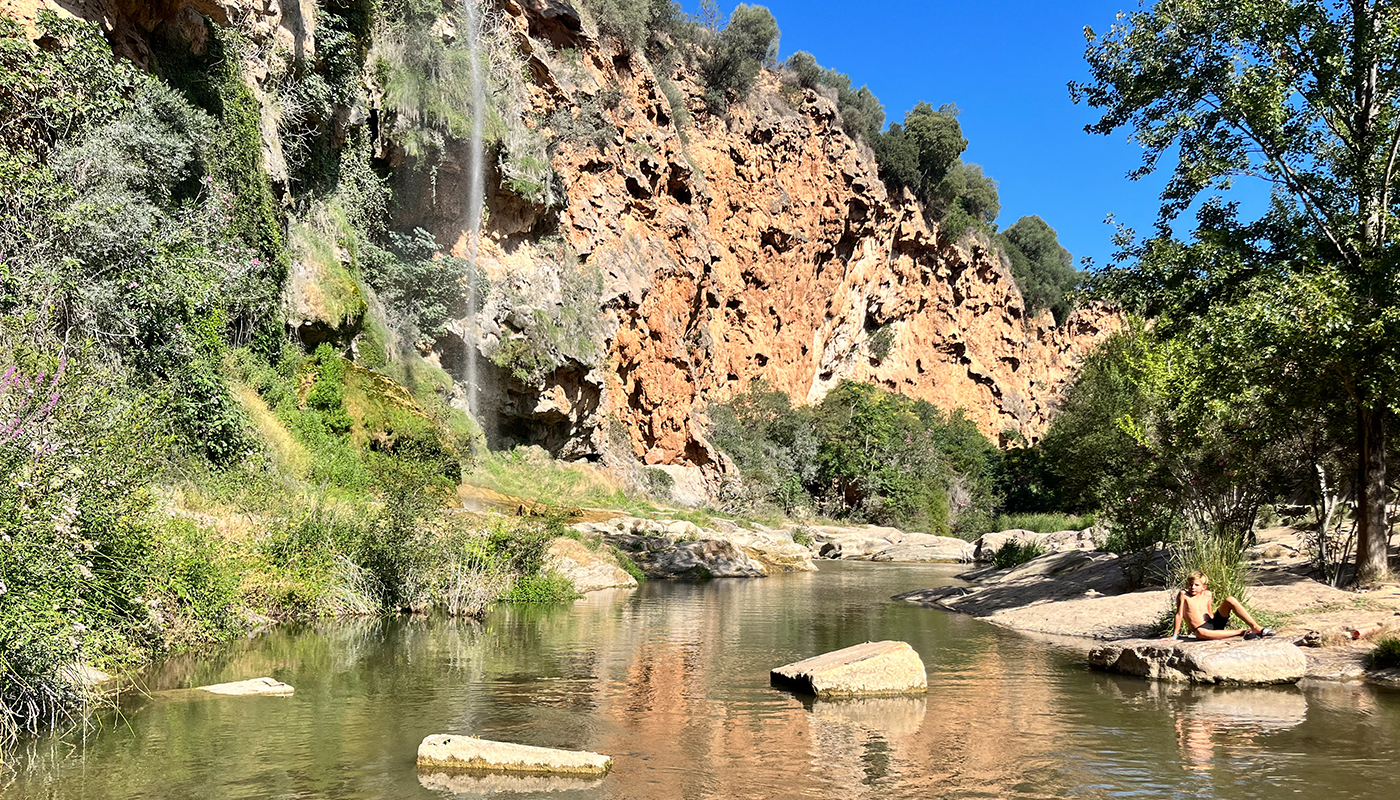Somewhere between the high plains of Aragón and the orange groves of the Mediterranean coast, there runs a thin, dusty ribbon of gravel called the Vía Verde de Ojos Negros. Once a railway ferrying iron from mines to the sea, it now serves a nobler purpose: guiding the mildly adventurous downhill on two wheels, away from email, concrete, and anything resembling a desk.
It was on this path that the three of us—Maria, Leo, and myself—set out with ebikes, two panniers, and just enough optimism to ignore the forecast. Spain, as it happened, was in the grip of a heatwave so persistent it had acquired a name—possibly Lucifer. We carried food, water, clothes for all eventualities (mostly involving sweat), and a modest repair kit we hoped we’d never need.
Our accommodation plan veered from spa comfort to tepee novelty, which felt about right for a trip that promised both sore legs and unexpected poetry. We began in Monreal del Campo, hearts full of wanderlust, sunscreen at factor 50, and batteries at 100%.

We woke to the gurgling hush of water and the creak of wooden beams in an old converted watermill on the edge of Monreal del Campo—a village that feels like a mirage with plumbing. Set amid the sun-baked scrublands of Aragón, Monreal is something of an oasis, thanks to an ancient and rather ingenious network of irrigation canals. These canals—narrow, stone-lined trickles of life—snake through town, each with a little gate allowing locals to divert water to their own neat allotments. It’s a community-managed system, I was told, dating back centuries. Socialised waterworks with a hint of medieval elegance.
But Monreal del Campo is known for something far more exotic than irrigation. This is one of Spain’s prime producers of saffron—that famously fiddly spice which costs more per gram than printer ink or gold. Each delicate crimson thread must be plucked by hand from a crocus flower in autumn, usually at dawn. It takes around 150,000 flowers to make a single kilogram. Saffron isn’t just a crop here; it’s a kind of slow poetry, written in purple and gold.
After wandering the village’s shaded lanes and admiring the little gardens (some with vegetables, others with a more aggressive approach to plastic flamingo décor), we sat down to breakfast. The air already hinted at the day’s coming heat, and our plan was simple: pedal to the start of the Vía Verde in Ojos Negros, a good warm-up before the long descent south.
The name Ojos Negros—“black eyes”—doesn’t refer to bar fights or romantic despair, but to the miners who once toiled in the iron-rich earth nearby. Their faces, blackened with soot and iron dust, gave the town its nickname. Mining here was big business in the early 20th century, and the Sierra Menera mining company even built its own private railway in 1903, stretching all the way to the port of Sagunto, 200 kilometres away. By the 1970s, the mines had fallen silent, and the train line followed suit in 1972.
But like all good things in Spain—castles, convents, shoes—the old was reimagined. In the early 2000s, the disused railway was reborn as the Vía Verde de Ojos Negros, now Spain’s longest greenway, and possibly its most poetic: a slow, almost imperceptible descent from mountain to sea, lined with ghostly stations, olive groves, and the occasional goat with boundary issues.
We reached Ojos Negros under a sky the colour of a gas hob, the sun already flexing its muscles for the day ahead. Ojos Negros, the town that gave its name to Spain’s longest greenway, turned out to be both sleepy and steeped in quiet resilience. Once the heart of the mining operation, it's now home to around 400 residents, most of them appearing to gather at what might be the most versatile establishment in Aragon—a café that doubled as the town’s grocery store, post office, and, judging by the animated conversation near the ice cream freezer, its de facto town hall.
We paused for coffee and a quick stock—I got chatting with a local abuela about the heatwave, which she blamed on everything from climate change to the regional government. When I explained our plan to cycle the Vía Verde, she gave me a look somewhere between admiration and quiet horror. There was a pause—long enough for a sparrow to cross the plaza—before she nodded slowly, as if processing the madness of it all. I couldn’t tell if she thought we were brave, foolish, or simply foreign. Perhaps all three. The heat, she assured me, was not just unusual, it was biblical.
The terrain had changed dramatically—the oasis charm of Monreal del Campo was long gone, replaced by harsh, open land—scrub, sun, and soil the colour of old clay pots. After several rounds with our GPS (which seemed to believe we were in rural Kazakhstan), and a helpful nudge from some locals, we finally found our way onto the Vía Verde proper. A smooth ribbon of gravel unfurled before us—and ahead, 90 kilometres of it to the city of Teruel. So, with batteries humming and spirits high, we pointed our handlebars south and pedalled into the dust.
Now, 90 kilometres is a respectable distance on any day. But when you’re hauling two panniers, nursing sun-scorched water bottles, and trying to maintain morale among three riders—one of whom is 11 years old—it becomes a minor epic. Leo, to his credit, pedalled on with a mix of stoicism and snack-based motivation. The only real wobble came just outside Teruel, where trail signs vanished into thin air and we, a bit frayed and frazzled, found ourselves cycling along the shoulder of a motorway, our bright bike jerseys flapping like emergency flags.
We finally rolled into our spa hotel in Teruel around 8:15pm, hot, dusty, and dreaming of jacuzzis. The spa, of course, had just closed at 8:00pm. We were graciously offered the two next best things: a shower and a very good dinner. We took both with grateful limbs. Maria claimed her backside had started arguing with her somewhere around Santa Eulalia, and now it was filing an official complaint. Leo demolished his dinner and fell asleep mid-sentence. Frankly, I was tempted to do the same.

The next morning began with what was, by now, a medical necessity: the spa. We soaked and floated and unwound —precisely the sort of preparation you don’t want before cycling 50km uphill in a heatwave. We eventually left around midday, which in Spain is roughly when the sun starts to laugh at you.
As we rode, the air changed. The dry heat of Aragon began to give way to something thicker, more Mediterranean. The land, too, shifted—greens slowly gave way to ochre and burnt orange, the hillsides like slabs of warm ceramic. It was beautiful, yes, but brutal. By mid-afternoon, we were flagging badly, and when we stumbled into the near-deserted village of Valdecebro, we were three overheated cyclists with hollow stomachs and low morale.
Enter Jesús, the patron saint of the afternoon. With a benevolence you rarely find outside of parables, he opened the town’s only bar just for us, whipped up three generous platos combinados, and kept the cold drinks coming. The town, he explained between refills, had just 25 residents, most of them stubbornly clinging to tradition and one another. It was, as they say, a true slice of la España vacía—the empty Spain.
Revived, rehydrated, and re-caffeinated, we hit the trail again. As we pedalled away from Valdecebro, we could hear Jesús recounting our visit to the only other visible resident—three sun-baked cyclists who’d blown into town half-dead and left grinning and full of grilled pork. We were, it seemed, already famous.
We’d originally planned to stop in Barajas, but the sun had other plans, and by 8pm, with shadows lengthening and legs trembling, we reached Valverde instead. Here, fortune smiled once again: a Casa Rural just off the trail, a lovingly restored stone building that once housed itinerant miners. Not only was it cool and welcoming—it boasted a Michelin-starred restaurant. You know you’ve made the right decision when the waiter describes the dessert of the day like it’s a distant relative.
The bikes were plugged in, our bellies were filled once more, and the beds—like everything else in that lovely house—were exceptional. We slept like people who had earned it. Because we had.

We left the rustic comforts of our casa rural with the reluctant shuffle of people who’d grown far too fond of clean sheets and stone walls. The plan, as ever, was noble if not entirely realistic: beat the heat by leaving early. We did our best. The trail was kind at first, and we pedalled through a string of handsome towns—Sarrión and Albentosa among them—pausing periodically for the sort of refreshments that require both shade and sugar.
In Albentosa, we found ourselves caught in a delightful snarl of local traffic—total gridlock, by village standards, involving three cars and a single Guardia Civil trying to direct them all with the gravitas of a man choreographing a moon landing. It was oddly entertaining, though the town holds far darker stories. During the Spanish Civil War, Albentosa was used as a detention site, its remote and rugged setting proving ideal for keeping people in—and help out. Many prisoners were left to endure the cruel mountain winter in makeshift shelters, and temperatures reportedly dropped as low as -20°C. It’s a sobering thought, especially when you're cycling in a heatwave.
Our decision to stop in Valverde the previous night felt wiser with every uphill turn. We arrived in Barracas in time for lunch—a town that might generously be described as “functional”—and found a roadside bar near an industrial park that served food, drink, and the holy grail: power sockets for our bikes. We charged ourselves and the bikes in tandem, eating slowly and silently, like people preparing for another slog.
From there, we pressed on through what felt like the wind farm capital of Spain. Turbines whirred stoically in the distance, and the trail finally, mercifully, began to descend. The landscape softened—pine forests began to reappear, the humidity crept up, and then we hit it: a vast, scorched tract of land recently ravaged by wildfire. The earth was charred, the trees blackened, and the silence heavy. It was beautiful in a stark, cinematic kind of way—like riding through the set of a post-apocalyptic spaghetti western.
The day’s final surprise came on the last downhill stretch into Navajas, just 10 kilometres from our stop, when my “puncture-proof” tyres apparently decided to test their limits. One hiss and a sigh later, I was off the bike, fixing it as best I could with a repair kit and the unexpected assistance of a fellow cyclist who appeared like a Lycra-clad superhero. With the wheel temporarily sorted, I veered off route to find a bike shop—closed, of course, for the sacred Spanish midday break.
We finally rolled into Navajas and our campsite accommodation just before 8pm, dusty, sweaty, and oddly elated. After 87 kilometres and 9 hours in the saddle, the sight of the swimming pool was enough to move us to tears—or it would have, had we not immediately cannonballed into it.
That night, as we unpacked our gear into a surprisingly spacious and spotless tepee, we allowed ourselves a moment of reflection. We’d come a long way—further than we’d realised—and the Mediterranean now felt tantalisingly close. We ate, we laughed, we quietly congratulated ourselves, and then we crawled into our canvas quarters and slept like explorers who’d outrun the sun. And for once, we had.

Camping means waking up early—mostly because your body insists—but also because it’s never quite as comfortable as you'd like. We packed up and wandered into Navajas in search of breakfast, as one does when the previous night involved a teepee and nine hours of cycling. Navajas, like many Spanish towns, revolves around a square—church, town hall, large shade-giving tree, and a scattering of men of a certain age solving the world’s problems over café con leche. It was all comfortingly familiar.
The square’s centrepiece was el Olmo, a 380-year-old elm tree that looked like it had seen a few revolutions and perhaps started one or two. As usual, there was a fountain—nearly all the ones we found on this journey offered drinkable water, drawn from the mountains and filtered through the land, nature’s very own Brita system.
We’d been told by Nacho, one of our Teruel saviours, not to miss the local waterfall—El Salto de la Novia (“The Bride’s Leap”). And so we followed a narrow cobbled path down into a gorge that wouldn’t be out of place in Northern Australia’s Katherine region—minus the crocodiles and giant lizards, of course. Better still, we had it all to ourselves. For an hour or so, we stood under the cool rush of water, a 30-metre cascade pounding the dust and fatigue off us like a high-powered mountain bidet. The kind of natural shower that resets both body and spirit.
The legend of the place is suitably tragic: once upon a time, a couple in love had to cross the river together as a test of their bond. If they made it, happiness awaited. If they didn’t… well, they’d drown. Apparently, one couple did just that. Romance, as always, comes with fine print. Thankfully, Maria and I crossed just fine—summer’s low water levels helping somewhat—and no one was swept away.
By the time the crowds began to arrive, we slipped out, back uphill to the trail—and were met by that now-familiar hiss of despair: another puncture. Despite the “anti-puncture” inner tubes (which now sounded more like wishful thinking than engineering), this was the second blowout of the trip. With no spare, we limped along to Segorbe, my tyre squirming like a jellyfish with anxiety. There, just before lunch, we found salvation in a bike shop run by the calm and competent Toni, who patched me up with the quiet efficiency of a man who’d seen it all before.
Unfortunately, the delay meant I’d likely miss the last train from Sagunto—which I needed to catch in order to retrieve the van waiting for us back in Monreal del Campo. It was a bit of a logistical mess. So we retreated to Altura, where a vast former reservoir had been transformed into a swimming pool the size of a football pitch. As we sipped drinks by the water and tried to make a plan, a Spanish couple at the next table overheard our dilemma—and did something remarkable.
They introduced themselves as David and Olaya, listened to our predicament, and without hesitation offered to drive me the full 300km round-trip back to Monreal. I initially refused, of course—there are limits to British awkwardness—but they insisted. “You’d do it for us,” they said, “and besides, we’ve got nothing else on.” True to their word, they wouldn’t accept petrol money, just company and conversation. We chatted the whole way—about bikes, places, people—and by the end, it felt less like a favour and more like meeting an old friend you never knew you had.
We didn’t get to ride the final few kilometres to Sagunto, but as it turned out, this was a blessing. That final stretch apparently involves navigating a busy national road—not exactly the poetic finale we’d imagined. Better, perhaps, to end where we did, surrounded by kindness and cool water, rather than trucks and tarmac.
Now, it’s often said that the Ojos Negros route is kid-friendly. Well, perhaps—but only if the child is made of titanium. Leo, at just 11 years old, managed what many adults might struggle to do, and Maria, as ever, was unwavering—positive, strong, and stubborn in the best possible way. We’d cycled 250km in four days, through heatwaves, dust, and detours. We missed some places (Cella, Albarracín, Caudé), but they’ll be waiting for next time.
This journey gave us more than we expected—new friendships, a sense of accomplishment, and a fresh appreciation for the kindness of strangers. We’ll be talking about this one for years. As for the future? The Pyrenees await. A tent, some stars, and maybe—just maybe—a route with fewer punctures.
Gracias, Ojos Negros. We’ll be back.
